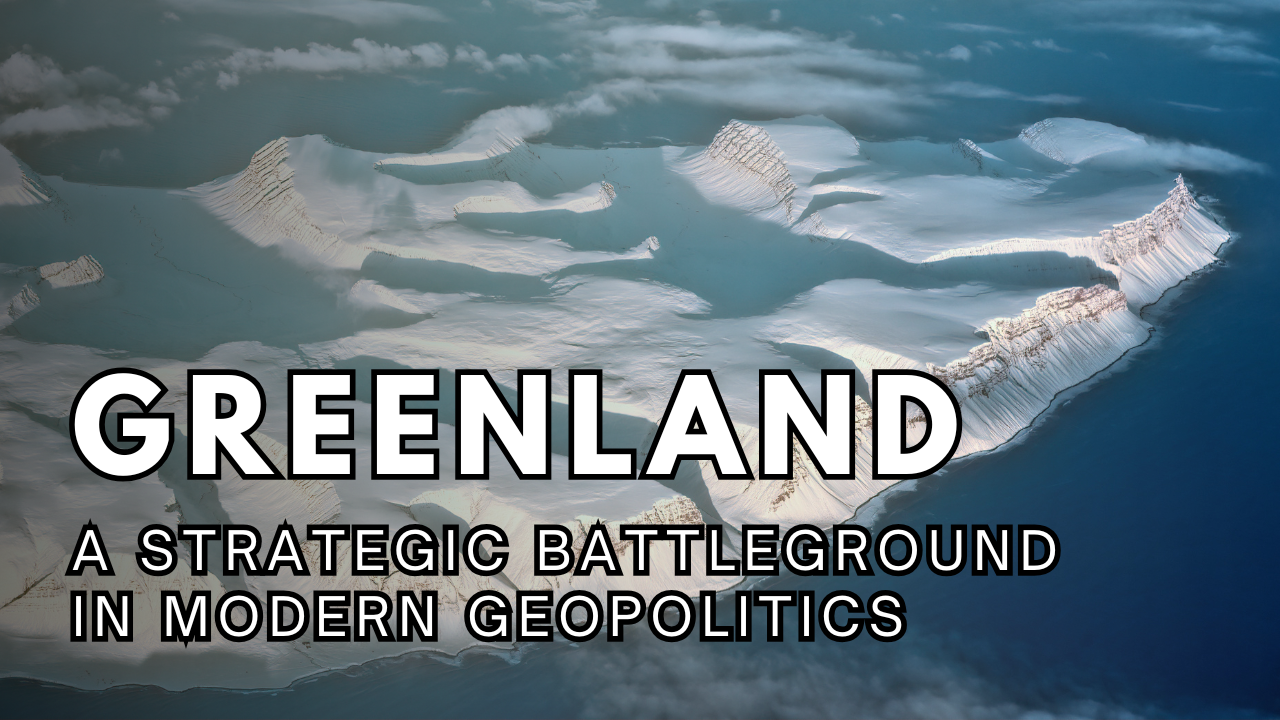Greenland: A Strategic Battleground in Modern Geopolitics
Introduction – Greenland
Greenland, long known for its icy wilderness, is increasingly becoming a hotspot of international interest. With its abundant resources, strategic location, and evolving governance, the world’s largest island is now at the heart of a modern geopolitical chess game. This essay explores how Greenland’s unique position reflects critical themes of global power dynamics, environmental challenges, and the complexities of sovereignty.
Greenland’s Emerging Importance: A Historical Perspective
Greenland’s strategic value has been recognised for decades. As far back as 1946, the United States offered to buy the island from Denmark, citing security concerns in the wake of World War II and the emergence of modern weapons. Greenland’s position between North America and Europe made it an invaluable military asset, leading to agreements that allowed the U.S. to establish bases such as the Thule Air Base (now Pituffik Space Base).
More recently, Greenland’s importance has grown due to its untapped resources and potential shipping routes exposed by melting Arctic ice. This increased interest has pushed Greenland into the global spotlight, making its governance and autonomy crucial topics of discussion.
Natural Resources: A Magnet for Global Powers
Greenland’s wealth of natural resources is one of the main drivers of international attention. It holds significant deposits of rare earth minerals, which are critical for modern technologies, including renewable energy systems, consumer electronics, and military equipment. Currently, China dominates the global supply of these minerals, making Greenland an attractive alternative for countries like the United States.
However, resource extraction in Greenland poses challenges. Its harsh climate and remote location make operations expensive and logistically complex. Public opinion in Greenland is also cautious about large-scale mining due to environmental and cultural concerns. This underscores the need for sustainable resource management that balances economic benefits with environmental preservation.
Climate Change: Opportunity and Threat
Climate change is reshaping Greenland in profound ways. The island’s melting ice sheet contributes significantly to global sea-level rise, making it a key focus for climate science. Yet, this melting also exposes previously inaccessible resources and opens new shipping routes, potentially transforming Greenland into a critical hub for maritime trade.
While these developments present opportunities, they also come with significant risks. Increased human activity in Greenland could threaten its fragile ecosystems, and the global race for Arctic resources raises questions about long-term sustainability and the rights of its Indigenous communities.
Geopolitical Rivalries: The New “Great Game”
Greenland’s strategic location has made it a focal point in the growing competition among major powers. The United States views Greenland as crucial to its Arctic strategy, emphasising its military importance and the need to counter rival influences, particularly those of China and Russia.
The United States and Greenland: The United States has long viewed Greenland as strategically important, but under President Trump, this interest reached unprecedented levels. His 2019 offer to purchase Greenland, though dismissed as absurd by Denmark and Greenland, highlighted its central role in U.S. defence and economic strategies. Greenland’s location within the GIUK Gap—a critical chokepoint for monitoring Arctic and Atlantic activity—makes it vital for U.S. security.
Trump’s efforts were not limited to verbal offers. Reports suggest he applied pressure, including threats of tariffs on Danish exports, during discussions with Denmark. His reasoning often referenced Greenland’s role in protecting the free world, asserting that U.S. control would enhance global security while countering rival influences.
Greenland’s resource wealth also attracts U.S. interest. The island holds significant rare earth deposits critical for modern technologies. Given China’s dominance in global rare earth production, Greenland offers the U.S. a strategic opportunity to diversify supply chains. Trump’s remarks acknowledged this economic rivalry and stressed Greenland’s importance in reducing dependency on Chinese resources.
Moreover, as Arctic ice melts, new shipping routes emerge, further amplifying Greenland’s significance. These developments align with U.S. interests in maintaining dominance over Arctic trade and security. Trump’s bold and often controversial approach underscored the geopolitical value of Greenland as a linchpin in global competition.
China’s Arctic Ambitions: China has also entered the Arctic scene, declaring itself a “near-Arctic state” and investing heavily in Greenland’s mining sector and infrastructure. Its “Polar Silk Road” initiative aims to integrate Arctic trade routes into its Belt and Road Initiative. However, Chinese investments in Greenland have raised concerns among Western powers about potential security risks.
Denmark’s Role: As Greenland’s sovereign, Denmark faces the challenge of balancing its commitments to NATO allies, like the U.S., with the growing influence of China. While Denmark retains control over Greenland’s foreign policy and defence, its ability to act is increasingly influenced by Greenlandic leaders asserting greater autonomy.
Greenland’s Autonomy: Balancing Sovereignty and Dependence
Greenland’s political journey towards self-determination has been marked by significant milestones, such as the 2009 Self-Government Act, which granted it extensive autonomy. However, its economic reliance on Danish subsidies complicates its path to full independence. This duality—a desire for sovereignty coupled with financial dependence—creates a delicate balancing act for Greenlandic leaders.
As international interest in Greenland grows, its leaders have skilfully used this attention to strengthen their political standing. By positioning Greenland as a key player in Arctic governance and asserting control over resource management, Greenlandic authorities are gradually expanding their influence on the global stage.
Challenges and Opportunities
Greenland’s growth on the global stage brings both challenges and opportunities. To ensure sustainable development, Greenland must expand its economy beyond fishing and mining. Promising areas include tourism and improved infrastructure, which could create jobs and reduce reliance on Danish subsidies while maintaining the island’s unique character and traditions.
Protecting Greenland’s fragile environment is another key concern. The island’s ecosystems, home to unique wildlife and vital to Indigenous communities, face threats from resource exploitation. Balancing economic progress with environmental preservation is essential to safeguard Greenland’s natural heritage for future generations and protect its role in Arctic climate research.
Greenland also faces complex diplomatic challenges. Managing relationships with powerful nations like the United States, China, and Denmark requires skilful diplomacy. Balancing its autonomy with external pressures is crucial, ensuring Greenland’s voice remains central in decisions affecting its resources, security, and global position in the rapidly changing Arctic.
Social equity is vital for Greenland’s stability. Development must benefit all citizens, particularly its Indigenous communities, who are deeply connected to the land and culture. Addressing issues like education, healthcare, and job opportunities is essential to build a prosperous, inclusive society that can thrive in the face of global attention and change.
Conclusion
Greenland’s journey from a remote Arctic territory to a central player in global geopolitics reflects the complexities of our interconnected world. Its vast resources, strategic location, and semi-autonomous governance position it as a pivotal arena for addressing pressing issues like climate change, resource management, and sovereignty.
As Greenland navigates this transformative period, its decisions will have far-reaching implications, not just for its people but for the Arctic and the world at large. By balancing development with sustainability, and independence with collaboration, Greenland has the potential to become a model for how small nations can shape their destinies in the face of global challenges.
Subscribe to our Youtube Channel for more Valuable Content – TheStudyias
Download the App to Subscribe to our Courses – Thestudyias
The Source’s Authority and Ownership of the Article is Claimed By THE STUDY IAS BY MANIKANT SINGH




